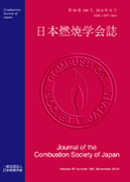Volume 45, Issue 132
Displaying 1-8 of 8 articles from this issue
- |<
- <
- 1
- >
- >|
FEATURE—Combustion Characteristics of DME and Future Scope for Its Energy Use
-
Article type: FEATURE
2003Volume 45Issue 132 Pages 69-75
Published: 2003
Released on J-STAGE: October 24, 2019
Download PDF (857K) -
Article type: FEATURE
2003Volume 45Issue 132 Pages 76-79
Published: 2003
Released on J-STAGE: October 24, 2019
Download PDF (604K) -
Article type: FEATURE
2003Volume 45Issue 132 Pages 80-85
Published: 2003
Released on J-STAGE: October 24, 2019
Download PDF (758K) -
Article type: FEATURE
2003Volume 45Issue 132 Pages 86-89
Published: 2003
Released on J-STAGE: October 24, 2019
Download PDF (533K) -
Article type: FEATURE
2003Volume 45Issue 132 Pages 90-94
Published: 2003
Released on J-STAGE: October 24, 2019
Download PDF (517K)
SERIAL LECTURE—New Simulation Methods in Combustion IV
-
Article type: SERIAL LECTURE
2003Volume 45Issue 132 Pages 95-102
Published: 2003
Released on J-STAGE: October 24, 2019
Download PDF (1061K)
ORIGINAL PAPER
-
Article type: ORIGINAL PAPER
2003Volume 45Issue 132 Pages 103-113
Published: 2003
Released on J-STAGE: October 24, 2019
Download PDF (1433K) -
Article type: ORIGINAL PAPER
2003Volume 45Issue 132 Pages 114-120
Published: 2003
Released on J-STAGE: October 24, 2019
Download PDF (1133K)
- |<
- <
- 1
- >
- >|
